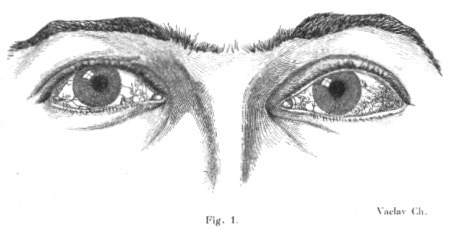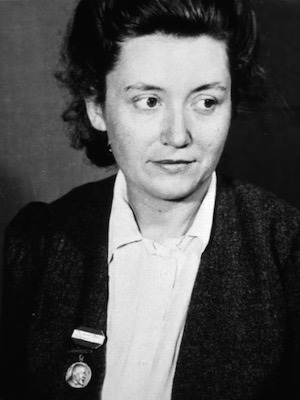Denise Louis-Bar
Denise Louis-Bar (1914 – 1999) was a Belgian neuropsychiatrist.
In Brussels, Louis-Bar practiced as a neuropsychiatrist assisting individuals with intellectual disabilities. She made major contributions to the establishment of special facilities for their care and to the development of techniques for their medical and social management.
She is eponymously remembered for her descriptions of ataxia-telangiectasia [Louis-Bar syndrome] (1941).
Biography
- 1914 – Born Denise Bar on April 3 in Liège, Belgium. Lived in Spain with her family until the age of 10
- 1939 – MD, with a joint degree in physical education from the Free University of Brussels. Married civil engineer F. Louis on August 8 adopting the hyphenated surname Louis-Bar
- 1940 – Resident at the Bunge Institute of Neurology, Antwerp with neuropathologist Ludo van Bogaert (1897-1989)
- 1943 – Lecturer in pharmacology, University of Liège
- 1945 – Neuropsychiatrist, University of Liège
- 1957 – Moved to Brussels to work as a psychiatrist, with a special interest in the care of individuals with intellectual disabilities.
- 1999 – Died 2 November in Brussels
Medical Eponyms
Louis-Bar syndrome (1941) [aka: ataxia-telangiectasia]
Louis-Bar syndrome is an autosomal recessive, early-onset multi-system neurodegenerative disorder characterised by progressive cerebellar ataxia, telangiectasia, immune defects, and a predisposition to malignancy. Patients usually present in early childhood with progressive cerebellar ataxia and later develop conjunctival telangiectasia, progressive neurologic degeneration, sinopulmonary infections, and malignancies. Early ataxia presentation can be misdiagnosed as ataxic cerebral palsy before the appearance of oculocutaneous telangiectases which typically develop between 3 and 5 years of age.
1926 – First description was reported by Czech physicians Ladislav Syllaba (1868-1930) and Kamil Henner (1895-1967) in their article Contribution a l’indépendance de l’athétose double idiopathique et congénitale published in Revue Neurologique. The report documented 3 adolescent siblings with progressive choreoathetosis; ocular telangiectasias; and they recognised that the disorder was familial.

Revue Neurologique 1926: 543
1940 – In an out-patient clinic at the Bunge Institute (Antwerp), Louis-Bar examined a 9 year old girl in whom progressive ataxia, intellectual disability and telangiectasia had developed in early childhood. Louis-Bar published her report in Confinia Neurologica in 1941 Sur un syndrome progressif comprenant des télangiectasies capillaires cutanées et conjonctivales symétriques, à disposition naevoïde et des troubles cérébelleux [On a progressive syndrome comprising cutaneous capillary and symmetric conjunctival telangiectasia, a disposition for nevi and cerebellar dysfunction]
The author reports the case of a 9-year-old child with a syndrome of the cerebellum with predominant ataxia-abasia together with speech disturbance and mental backwardness progressively developing since the third year of life. As regards the skin, the child shows patches of telangiectasies (different from simple angioma) regularly and symmetrically arranged as also systematically ordered “café au lait” spots of fern like appearance. The double state as regards skin and nerves permits this case to be placed generally in the sphere of the phakomatosa without assigning it any particular form
Louis-Bar 1941: 41
1957 – Elena Boder (1908-1995), a Russian-American pediatric neurologist and Robert Sedgwick, provided a preliminary report of 7 cases and in 1958 published a series of 8 cases of ataxia-telangiectasia linking the hereditary component of the condition. Boder and Sedgewick proposed the term Ataxia-telangiectasia for the familial syndrome of progressive cerebellar ataxia, oculocutaneous telangiectasia and frequent pulmonary infection. They acknowledged the “prophetic clinical report of a single non-familial case without an autopsy, published by Louis-Bar in 1941” and admitted that the original description contained the two essential components of the syndrome. However, the authors still claimed they had isolated a “relatively new syndrome which has been established as a distinct entity only within the last five years”.
1958 – The eponymous term ‘Louis-Bar syndrome’ was first proposed by Willard Centerwall and Melba Miller in a publication concerning two patients with ataxia-telangiectasia. [AMA J Dis Child 1958]
…certain syndromes which involve the skin, eye, and central nervous system, i.e. cephaloretinal angiomatosis (von Hippel-Lindau disease), cerebral angiomatosis (Sturge-Weber syndrome), neurofibromatosis (von Recklinghausen’s disease), and tuberous sclerosis (Bourneville’s disease). Following these examples of labeling by pathology and by proper names, it would seem reasonable to call this syndrome “cephalo-oculocutaneous telangiectasia” (Louis-Bar syndrome). It makes an interesting finis to note that Ludo van Bogaert who, in 1940, referred that first case of “cephalo-oculocutaneous telangiectasia” to Madame Louis-Bar is the same person who, five years earlier, had coined the term neuroectodermal dysplasias.
Centerwall, Miller 1958: 394
1964 – However, controversy over nomenclature continued on… Miller and Goody argued that Madame Louis-Bar first clearly delineated the syndrome, which later had been given a more detailed set of descriptive features.
For all these reasons, of acknowledgment of a brilliant isolation of a clinical entity, of comprehensiveness without closing the door of solution upon the disorder, of euphony, and of credit where credit is due, let us agree, at any rate for the time being, to label this disorder as “the Louis-Bar syndrome.”
Miller, Goody 1964: 586
1967 – Henner submitted a manuscript titled “Apropos of the description of ‘Ataxia teleangiectasis’ by Mme Louis-Bar. Priority of the description, by Lad. Syllaba and K. Henner in 1926, of the conjunctival vascular network”. The article was published in Revue Neurologique in 1968, a year after Henner’s death.
Ataxia-telangiectasia is the predominant term used for the disease, however, the eponymous term Louis-Bar syndrome still persists in the medical literature.
Major Publications
- Louis-Bar D. Sur un syndrome progressif comprenant des télangiectasies capillaires cutanées et conjonctivales symétriques, à disposition naevoïde et des troubles cérébelleux. Confinia Neurologica. 1941; 4: 32-42 [Louis-Bar syndrome]
- Louis-Bar D. Sur les semiologie et anatomie pathologique de l’angiomatose caverneuse et telangiectasique des centres nerveux. Monatsschrift für Psychiatrie und Neurologie 1946;111:225–272.
- Louis-Bar D. Sur le syndrome vasculaire de l’hemibulbe (Wallenberg). Monatsschrift für Psychiatrie und Neurologie 1946;112:53–107.
- Louis-Bar D. Sur l’heredite de la maladie de Sturge-Weber-Krabbe. Confinia Neurologica 1946;7:238–244.
- Louis-Bar D. Paralysis of cyclists. Revue médicale de Liège 1952;7:82–83.
- Louis-Bar D. Two cases of narcolepsy. Revue médicale de Liège 1952;7:312–313.
- Louis-Bar D, Keil C. Essential epilepsy. Revue médicale de Liège 1954;9:359–363.
- Louis-Bar D. The interview with the parents. Acta Neurol Psychiatr Belg 1964;64:934–941. [Louis-Bar syndrome]
Controversies
Priority for the syndrome has been argued. The first description is often deemed to be that of Syllaba and Henner (1926) .
References
Biography
- Evrard P, Beya A, Provis M. Denise Louis-Bar. In: Ashwal S (ed) The Founders of Child Neurology. Norman Publishing. 1990: 774-777
- Beighton P, Beighton G. Denise Louis-Bar. In: The Person Behind the Syndrome. Springer 1996: 110-111
- Coon EA, Koehler PJ, Boes CJ. Denise Louis-Bar: The eponymous woman of Louis-Bar syndrome. Neurology. 2018; 91(4): 175-179.
- Bibliography. Louis-Bar, Denise. WorldCat Identities
Eponym
- Syllaba L, Henner K. Contribution a l’indépendance de l’athétose double idiopathique et congénitale, Revue Neurologique 1926; 1: 541–562.
- Boder E, Sedgwick RP. Ataxia-telangiectasia; a familial syndrome of progressive cerebellar ataxia, oculocutaneous telangiectasia and frequent pulmonary infection. Pediatrics. 1958;21(4):526-554.
- Centerwall WR, Miller MM. Ataxia, telangiectasia, and sinopulmonary infections; a syndrome of slowly progressive deterioration in childhood. AMA J Dis Child. 1958;95(4):385-396.
- Miller SJ, Gooddy W. Madame Louis-Bar’s syndrome; a case record, with comments upon the name, classification and significance of this disorder. Brain 1964; 87: 581–588
- Martin L. The nosological position of ataxia-telangiectasia retrospective study of the first observation. J Neurol Sci. 1966;3(1):2-9.
- Henner K. A propos de la description par Mme Louis-Bar de l'”Ataxia teleangiectasia”. Priorité de la description, par Lad. Syllaba et K. Henner en 1926, du réseau vasculaire conjonctival [Apropos of the description of “Ataxia teleangiectasis” by Mme Louis-Bar. Priority of the description, by Lad. Syllaba and K. Henner in 1926, of the conjunctival vascular network]. Revue Neurologique. 1968; 118(1): 60-63.
- Boder E. Ataxia-telangiectasia: some historic, clinical and pathologic observations. Birth Defects Original Article Series 1975;11:255–270.
- LOUIS-BAR SYNDROME. OMIM 208900. OMIM
Graduated from Cardiff Medical School in 2017 with MBBCh and BSc in Psychology and Medicine. Currently working as a doctor in the emergency department at Sir Charles Gairdner Hospital in Perth, Australia.
BA MA (Oxon) MBChB (Edin) FACEM FFSEM. Emergency physician, Sir Charles Gairdner Hospital. Passion for rugby; medical history; medical education; and asynchronous learning #FOAMed evangelist. Co-founder and CTO of Life in the Fast lane | On Call: Principles and Protocol 4e| Eponyms | Books |


